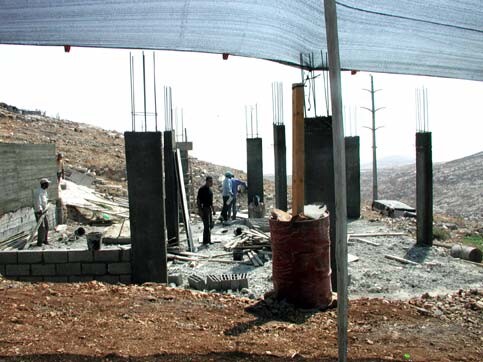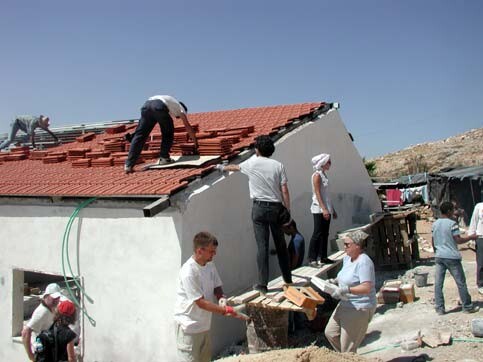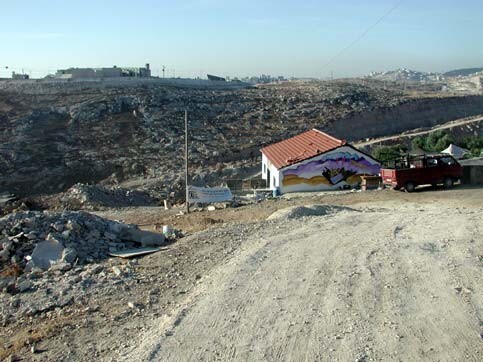West Bank 18 September 2003

Beit Arabia on day 1 of the work camp. Foundations had been laid by skilled Palestinian workers. (Kathy & Bill Christison)
We spent three weeks in Jerusalem and the West Bank in August, working on a project to rebuild a Palestinian house demolished by Israeli bulldozers. What we were actually building — under the sponsorship of the Israeli Committee Against House Demolitions (ICAHD) led by Jeff Halper — was a memorial and museum dedicated to the entire house-demolition/house-rebuilding phenomenon in Palestine-Israel. Although this building was not intended as a family home, it was constructed on the site of a home that the Israelis have demolished four times in the last five years, most recently in April 2003.
The project was deliberately intended as an act of defiance against the Israeli occupation — a kind of finger in the eye of the occupation — in which Israelis, Palestinians, and large numbers of internationals worked together hauling cement blocks, carrying buckets of sand and plaster, raising roof beams, planting, and painting. (Palestinians did the skilled labor; the rest of us did the brainless bucket-brigade work.) The internationals came from France, Germany, the UK, and Japan, in addition to the United States, and we were joined by rotating delegations from various Israeli and Palestinian-Israeli peace groups and from church organizations. We also received a lot of help, and much friendship and laughter, from a large contingent of neighborhood children, many of them residents of the Jahalin Bedouin encampment that hosted us and provided protection.

Palestinian, Israeli, and international workers and volunteers lay roof tiles. (Kathy & Bill Christison)
The end product is a small peace center, dedicated to three women: Arabia Shawamreh, whose house used to sit on this place; Nuha Sweidan, a young Palestinian woman, nine months pregnant, who was killed when Israeli bulldozers demolished her house in Gaza in March while she was inside; and Rachel Corrie, the young American run over by a bulldozer in Gaza in March. The center has been named Beit Arabia, Arabia’s House, after the first of these women. Arabia and her husband, Salim Shawamreh, parents of seven children, first built their family home in 1994 in the small West Bank town of Anata, just outside Jerusalem. They built without a permit because the Israelis had rejected their permit application three times on specious grounds. One day during lunch time four years later, 300 Israeli soldiers came unannounced and demolished the house, and since then it has been rebuilt with ICAHD’s help and demolished by Israel three more times. Arabia is so traumatized by having her home demolished multiple times that she now refuses to live there, so the family rents a place elsewhere in Jerusalem. She did, however, come to the work site regularly for two weeks to fix three marvelous meals daily for about 30-40 workers and volunteers.
When a contingent of Israeli police, soldiers, and civilian occupation officials-led by the Civil Administration official who had been present at each previous demolition-paid the work site a call two days before completion of the project and threatened a fifth demolition, Arabia confronted the Israelis. Buttressed by the huge outpouring of international support (in the words of Jeff Halper, she “blossomed in the love and attention she received”), she told Halper that this “was the first time in years I was not afraid.” Perhaps impressed by her courage, the Civil Administration official turned patronizing. In the it’s-for-their-own-good manner of all colonialists, he told the work camp organizers that ICAHD was simply egging the Shawamrehs on, so that “every time we have to demolish the house, they are diminished.” Always blame the victim, who of course cannot understand the civilizing mission of the colonialist.
Three weeks after the project’s completion and dedication, the building is still standing, but that is no guarantee. Groups of peace activists keep a constant vigil, spending nights at the center in case the Israelis come, as they often do, in the early morning hours. But these activists cannot save the center and will only be witnesses to Israel’s brutality.

The completed mural, showing a disabled Caterpillar bulldozer, discarded weapons, and Palestinian, Israeli, and American demonstrators protesting the occupation, with the spirits of Nuha Sweidan and Rachel Corrie hovering over the scene. (Kathy & Bill Christison)
An internationally known artist and labor activist, Mike Alewitz, who has created peace murals elsewhere, including at Chernobyl, painted a beautiful mural covering one entire outside wall of the peace center. The centerpiece of the mural is a disabled bulldozer (labeled “CAT-made in USA”) sitting on a pile of heavy weapons discarded in a heap. Demonstrators carrying anti-occupation banners in Arabic, Hebrew, and English are depicted at either end of the mural, and the spirits of Rachel Corrie and the young Palestinian woman, Nuha Sweidan, float above everything.
The site for the house is halfway down an extremely steep and rocky hillside that runs down to a wadi at the bottom of a narrow canyon. It is generally a very quiet, isolated spot, except that just a few months ago, the Israeli security service Shin Bet began building its principal interrogation and detention center, a replacement for the Russian Compound in the heart of Jerusalem, at the top of the hill on the opposite side of the canyon. It is not completed yet, but work proceeded on the site every day, and we knew from the start there were people over there who knew what we were doing. The juxtaposition of a huge fortress with watch towers and heavy fortifications all around facing a very small, roughly 900 square foot house, looking like nothing so much as a small Swiss chalet perched across the canyon, makes quite an image.

Beit Arabia, nearly completed. The hills of Jerusalem are in the distance. The new Shin Bet interrogation and detention center looms across the wadi, and the road bed for a new settler bypass road is visible on the opposite hillside. (Kathy & Bill Christison)
The organizers broke up the work by taking us on several very political tours—one around Jerusalem to see how massive Israeli settlements have ringed the city, intended to prevent any Palestinian expansion and preclude any Israeli territorial concessions in this strategic area; another to see the “separation wall” that Israeli is building, entirely on Palestinian land and well inside the West Bank, as a security barrier and probably a future borderline; and to the Negev desert to see several Bedouin villages, unrecognized by Israel but populated by Palestinian Bedouin who are citizens of Israel, where Israel is demolishing homes in another effort to prevent Arab expansion.
On the separation wall tour, we almost got ourselves arrested. We were a group of about 20 people, led by Jeff Halper and another Israeli peace activist, and had gathered under a canopy set up outside the house of a Palestinian family whose front yard has literally just been confiscated by the Israelis to build the wall. The Palestinian owner of the land was explaining what had happened when two Israeli soldiers came up and said we could not be there because it was a “closed military area.” Halper told the soldiers they needed a written order before they could legally force us to leave, so they went away, but a few minutes later they returned with their commander and a written order. He said he would arrest us “with violence” if we refused to leave. Although many of us had volunteered to be arrested at our own work site if the Israelis came, this was not the place to make a stand, so we left. The Palestinian family had prepared lunch for us, so they gave us the lentil soup and hummus and bread to take with us, and we went off and had a picnic. It was all a bit bizarre; all of us were madly taking pictures of this whole thing even while we were under threat of arrest!
The work camp broke up on August 21 after a rousing dedication ceremony attended by large numbers of Palestinian officials, Israeli peace activists, and church groups. In a wrap-up of the two weeks’ activities circulated a few days later, Jeff Halper wrote that in the atmosphere of reconciliation generated by the work camp and the dedication ceremony, “the notion that Israelis and Palestinians are enemies, that our conflict is somehow primordial, preordained and irresolvable, is seen for what it is: absolutely ridiculous, the product of people with a vested interest in conflict, occupation and domination.”
This has been the greatest lesson of this experience for us two: to learn that there are Israelis like Halper and the others who led this project who recognize Palestinians not as enemies, not as subjects, not as non-Jews who are different from and lesser than Jews, but as equal human beings with equal political and civil rights. For these Israelis, Jewish predominance is less important than ensuring a decent existence for Palestinians, and for them, it is worth risking their own safe and secure existence to bring equality to their neighbors.
We are all waiting for the day when the Israeli government, in its infinite wisdom, decides the time has come to teach us all a lesson, or whatever is in its mind when it demolishes homes-homes that in the circumstances of the occupation are the only structure in Palestinian lives, the only protection against an enemy bent on their destruction, the only refuge against people, as Halper describes the Israeli leadership, “with a vested interest in conflict and domination.”
“We pray that the house/center will continue to stand,” wrote Halper in an appeal to the international community, “and we ask each of you to monitor its fate. If Beit Arabia is allowed to function, it will become a center for Palestinian/Israeli political strategizing, as well as a place where journalists, diplomats, students and activists can learn about the conflict and meet key players. It will contain a library of resource materials and an exhibit of house demolitions, and will be available to any Palestinian, Israeli or international group that wishes to use its facilities. If Beit Arabia is demolished, we want the word to spread near and far. We cannot let the Occupation win. We must rebuild every time they demolish. And for that we will need your help and support. Stay in touch with us.”
Related Links
Kathy and Bill Christison are both retired CIA political analysts. Kathy has been a freelance writer since resigning from the CIA in 1979, dealing primarily with the Palestinian-Israeli conflict. Her book Perceptions of Palestine: Their Influence on U.S. Middle East Policy was published in 2001. A second book, The Wound of Dispossession: Telling the Palestinian Story, was published in 2002. Bill served on the analysis side of the CIA for 28 years before retiring in 1979. He served as National Intelligence Officer, principal adviser to the Director of Central Intelligence on certain areas, for Southeast Asia, South Asia, and Africa. In his last position, he was director of the CIA’s Office of Regional and Political Analysis. Since retiring, he has written extensively on the root causes of terrorism and the problems of U.S. foreign policy.



